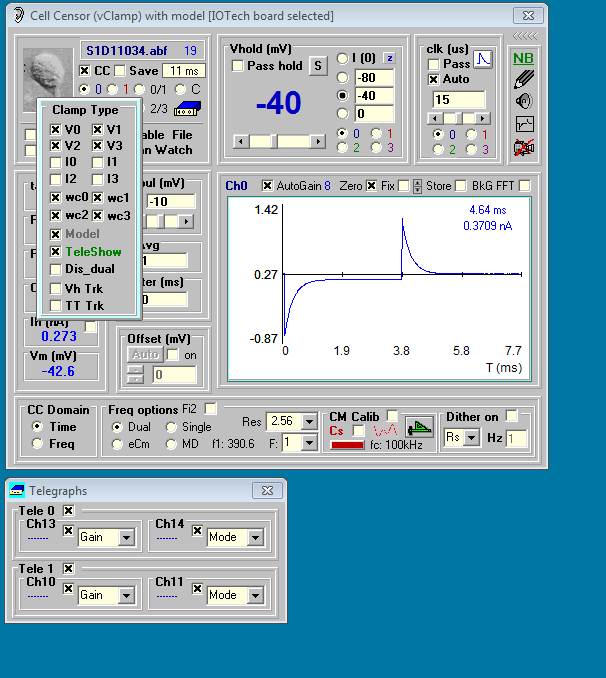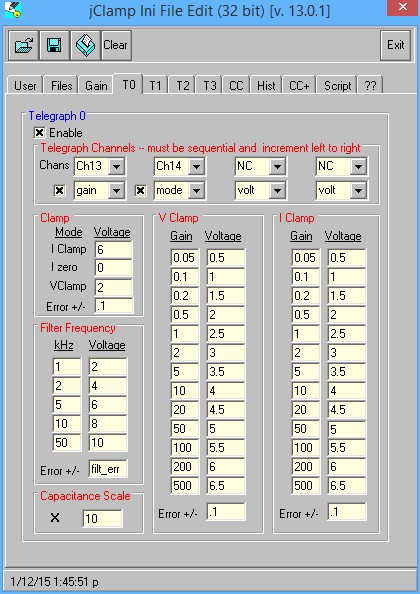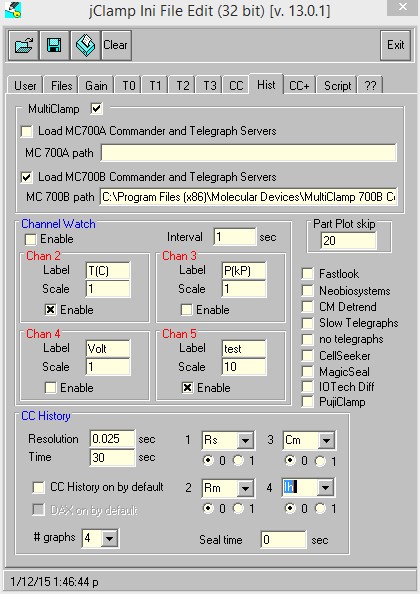Telegraph

Telegraph – under the Cell Censor window telegraph information is shown in a separate window if the TeleShow box is checked. Only those channels enabled in the ini file are shown, that is, they must be enabled in the ini file. Up to four channels are available for monitoring of Channels 0/0; and up to four channels are available for monitoring of Channels 1/1. Same for chans 2/2/ and 3/3. The channel numbers and function are set in the ini file. Available channels are from 4 to 15, but if 4-7 are used, Channel Watch function will simply look at the telegraphs, and not be available for monitoring other devices. For each telegraph, the channel numbers must be consecutive. Each channel(s) can have any of five functions, viz., NC - not connected, VOLT - simple monitoring of the voltage on that channel, GAIN - monitoring of gain telegraph output from a patch clamp amplifier, FREQ - monitoring of the filter frequency telegraph output from a patch clamp amplifier, CAP - monitoring of the capacitance telegraph output from a patch clamp amplifier, MODE - monitoring of the mode (voltage or current clamp or Izero) telegraph output from a patch clamp amplifier. You should always shift from voltage to current clamp by first changing to Izero. Amplifier knobs usually do this. For the Multiclamp, you should do this by mouse click in their MultiClamp window. The GAIN and MODE are special cases where jClamp can take action on the telegraph input. Therefore, check boxes are also displayed under these conditions. If enabled by checking, GAIN will automatically rescale the incoming A/D data to correct for the new patch clamp gain. If enabled by checking, MODE will automatically switch jClamp between current and voltage clamp modes. The telegraph values are equated with their specific amplifier definitions in the INI file. If the voltage connected to the MODE telegraph input is undefined (e.g. if the amplifier is turned off), then an asterisk is displayed next to the mode which is set to the selected (checked) mode setting for the affected channel. It is useful to use the VOLT function while altering amplifier gain or mode in order to determine whether voltage levels are as specified in the amplifier manuals. If not, actual values can be used in the INI file. Evaluations of telegraph input are made with an error window defined in the INI file. For the DAQP-308 board only Gain and Mode are available for the two CC Censor channels, since only a total of 8 input channels are available..

The telegraph inputs on the AXDD132x systems are not used. The above details apply instead.
The Axon Multiclamp Telegraph system is supported. Support for the 700A and 700B is provided. You must select the Multiclamp telegraph checkbox in the History tab of the jclamp ini file editor and you must select the channels to use (although the physical channels are not actually used). Also jClamp automatically sets up telegraphs as enabled in the jClamp ini file. You need to supply paths to the Multiclamp 700A or 700B executable (700A.exe or 700B.exe).

In the ini file under <History Tab>, you can set some features. Checking <no_tele> will disable telegraph checking and allow you to enter a gain manually in the tele gain box. Checking <slow_tele> will allow checking telegraphs every so often as a Windows clock allows, about a few hundred milliseconds, else every time a CC data point is collected. If you check slow then CC collections could be faster. You may need to check fast so you can switch between current and voltage clamp without a glitch (e.g., possibly giving a larger stimulus than wanted [imagine in voltage clamp you give 10 mV steps in CC, then you switch to current clamp. If jClamp doesn’t respond between the delivery of stimuli, it could be possible to inject a 10 nA signal because internal scale factors would not have been changed to current clamp in time]. For this reason default is fast check.
